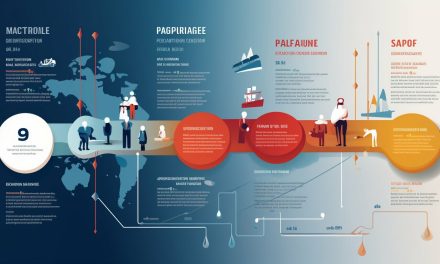The modern professional landscape has undergone a significant transformation in recent years, driven by the need for flexibility and work-life balance. As organizations adapt to the challenges posed by the COVID-19 pandemic, the concept of workplace flexibility has become a critical component of workplace strategy.
Today’s professionals are seeking employment arrangements that offer greater autonomy and control over their work schedules. By embracing flexible work arrangements, employees can achieve a better balance between their professional and personal lives. According to recent data, employees with a good work-life balance are 21% more productive.
As we navigate this new paradigm, it’s essential to understand the dimensions of workplace flexibility and how they can be leveraged for career advancement and personal well-being.
Table of Contents
Key Takeaways
- Understand the concept of workplace flexibility and its importance in the modern professional landscape.
- Discover how flexible work arrangements can enhance your career trajectory.
- Learn strategies for maintaining productivity and professional growth in flexible work environments.
- Explore the different dimensions of workplace flexibility and their impact on work-life balance.
- Find out how to leverage work flexibility solutions for career advancement and personal well-being.
Understanding Work Flexibility in Today’s Professional Landscape
The modern workplace is undergoing a significant transformation, with work flexibility at the forefront of this change. As we navigate this new landscape, it’s essential to understand the role of flexibility in shaping our professional lives.
Defining Workplace Flexibility
Workplace flexibility refers to the ability of employees to have control over their work schedules and environment. This can include remote work, flexible hours, or other arrangements that allow employees to balance their work and personal life more effectively. In essence, it’s about creating a work environment that supports the diverse needs of the workforce.
The Evolution of Flexible Work After COVID-19
The COVID-19 pandemic served as a catalyst for the adoption of flexible work arrangements. As lockdowns forced businesses to adapt, the experiment with remote work demonstrated that many roles could be performed effectively outside traditional office environments. This experience has led to a shift in how organizations approach work flexibility, with many now implementing hybrid models that blend remote work and in-office work. The focus has moved from debating the validity of flexible work to optimizing work arrangements for better productivity and employee satisfaction.
The evolution of flexible work represents a fundamental shift in workplace culture, prioritizing outcomes over physical presence. As organizations continue to gather data on productivity, employee satisfaction, and operational efficiency in various flexible arrangements, the future of work is likely to be shaped by the lessons learned during this period.
Types of Work Flexibility Solutions

Work flexibility solutions are transforming the way we approach our careers. As professionals seek better work-life balance and organizations strive for talent retention and productivity, various flexibility models have emerged.
Remote and Hybrid Working Models
Remote and hybrid working models offer employees the flexibility to work outside traditional office settings. Remote work allows employees to work from anywhere, reducing commuting time and increasing productivity for many. Hybrid models combine remote work with office days, providing a balance between flexibility and face-to-face interaction. These models are particularly beneficial for roles that require collaboration and independent work.
- Enhanced work-life balance through reduced commuting
- Increased productivity due to reduced office distractions
- Better talent acquisition and retention for employers
Flexible Scheduling Options
Flexible scheduling options enable employees to adjust their work hours to suit their needs. This can include flexible start and end times, compressed workweeks, or adjusting hours to accommodate personal appointments. Flexible scheduling is particularly valuable for employees with caregiving responsibilities or those pursuing further education.
Job Sharing and Part-Time Arrangements
Job sharing and part-time arrangements offer additional avenues for employees to customize their work experiences. These arrangements allow individuals to share responsibilities with colleagues or reduce their working hours while still maintaining employment. By dividing workload among multiple employees or adjusting work hours to accommodate personal commitments, job sharing and part-time arrangements facilitate greater flexibility.
- Job sharing involves splitting the responsibilities, hours, and benefits of a single full-time position among multiple employees.
- Part-time arrangements allow employees to work fewer than standard full-time hours, providing flexibility for those balancing work with other responsibilities.
- These arrangements help retain skilled professionals during life transitions and reduce turnover costs for organizations.
The Impact of Work Flexibility on Career Development

Work flexibility has emerged as a key factor influencing career development, offering numerous benefits and opportunities. As professionals navigate their careers, understanding the impact of flexibility on their growth and advancement is crucial.
Expanding Career Opportunities Through Flexibility
Flexible work arrangements can significantly expand career opportunities. By allowing employees to balance their work and personal life more effectively, flexibility can lead to increased job satisfaction and productivity. This, in turn, can open up new avenues for career advancement. According to a study, employees who work flexibly are more likely to take on additional responsibilities and pursue new challenges, thereby enhancing their career prospects.
Flexibility fosters a culture of innovation and creativity, enabling professionals to explore different approaches and solutions. As a result, organizations can benefit from a more diverse and skilled workforce.
Building Diverse Skill Sets in Flexible Environments
In flexible work environments, employees have the opportunity to develop a wide range of skills. By working on various projects and collaborating with different teams, professionals can build diverse skill sets that are highly valued by employers. The adaptability required in flexible work arrangements encourages employees to be more proactive and resourceful, further enhancing their skill development.
Moreover, flexible work arrangements often involve leveraging technology and digital tools, which can lead to the development of technical skills that are essential in today’s digital economy.
Overcoming Career Advancement Misconceptions
Despite the benefits of flexible work, some professionals harbor misconceptions about its impact on career advancement. A common misconception is that flexible workers are less committed to their careers. However, research shows that flexibility often increases engagement, productivity, and organizational loyalty. As one expert notes,
« The assumption that physical presence in the office correlates with productivity and dedication is outdated. Outcomes matter more than visibility. »
- Flexible work arrangements do not hinder career progression; in fact, they can accelerate it through increased productivity.
- Creating visibility mechanisms and equitable evaluation processes is crucial for the career advancement of flexible workers.
- Successful flexible workers employ intentional connection strategies to maintain professional relationships.
By understanding and addressing these misconceptions, professionals can make informed decisions about their career paths and leverage flexibility to their advantage.
Benefits of Work Flexibility for Professional Growth
Work flexibility plays a pivotal role in fostering professional growth and employee well-being. By allowing individuals greater control over their work schedules and environments, companies can mitigate the risk of burnout, enhance resilience, and foster a healthier and more sustainable workforce.
Enhanced Productivity and Innovation
Flexible work arrangements enable employees to work in environments that suit them best, leading to enhanced productivity. With the autonomy to structure their work, professionals can implement preventative self-care practices, reducing the likelihood of reaching crisis points that require extended leaves of absence. This autonomy also fosters a culture where well-being is valued alongside productivity.
Studies have shown that employees with flexibility options have 22% higher engagement levels. The ability to customize work arrangements to individual preferences and life circumstances creates a more personalized employment experience, naturally increasing job satisfaction and organizational commitment.
Improved Work-Life Balance and Well-being
Work flexibility directly addresses key burnout factors by reducing chronic workplace stress, eliminating exhausting commutes, and providing recovery time when needed. This leads to an improved work-life balance, which is crucial for maintaining employee well-being. When professionals feel trusted to manage their work independently, they report greater alignment between their work and personal values, a key component of meaningful work that drives long-term satisfaction and career sustainability.
Reduced Burnout and Increased Job Satisfaction
Organizations offering flexibility experience reduced turnover, typically 10-20% lower than industry averages, indicating higher job satisfaction and stronger employee retention even during competitive labor markets. The autonomy provided by flexible work arrangements allows professionals to manage their work in a way that reduces the risk of burnout, leading to increased job satisfaction.
| Benefits | Description | Impact |
|---|---|---|
| Enhanced Productivity | Flexible work environments suit employees’ needs | Increased efficiency and output |
| Improved Work-Life Balance | Reduced commute and stress | Better well-being and personal alignment |
| Reduced Burnout | Autonomy in work management | Lower turnover rates and higher retention |
For more insights on how flexibility can impact your career, you may want to explore the benefits of self-employment.
Implementing Work Flexibility in Your Career
To successfully integrate work flexibility into your career, it’s essential to start by understanding your personal and professional needs. This understanding will serve as the foundation for making informed decisions about the types of flexible arrangements that best suit your lifestyle and career goals.
Assessing Your Flexibility Needs and Goals
Begin by evaluating your current work situation and identifying areas where flexibility could significantly impact your work-life balance. Consider your productivity patterns, family commitments, and long-term career aspirations. This assessment will help you determine the most beneficial flexible work arrangements for your situation.
- Identify your most productive work hours and settings.
- Consider your family and other personal commitments.
- Reflect on your long-term career goals and how flexibility can support them.
Negotiating Flexible Arrangements with Employers
Once you have a clear understanding of your needs, it’s time to discuss flexible work options with your employer. Prepare a proposal that highlights the benefits of flexibility for both you and the organization, such as enhanced productivity and job satisfaction. Be open to negotiation and potential compromises, such as setting clear boundaries and performance metrics.
For more insights on achieving a better balance between work and personal life, you can explore resources like work-life balance tips.
Creating Structure and Boundaries in Flexible Work
To avoid the pitfalls of flexible work, such as working longer hours at home without a clear schedule, it’s crucial to establish a structure and clear boundaries. This includes defining specific work hours, creating a dedicated workspace, and developing routines that signal the start and end of your workday.
- Establish a dedicated workspace to separate work from personal life.
- Develop consistent routines to signal work and personal time transitions.
- Implement digital boundaries, such as specific notification settings.
Overcoming Challenges of Flexible Work Arrangements
Embracing flexible work arrangements requires a nuanced understanding of the potential pitfalls and how to navigate them. While flexibility can enhance career development and work-life balance, it also introduces challenges such as maintaining visibility, effective communication, and managing time effectively.
Maintaining Visibility and Professional Presence
To maintain visibility in a flexible work environment, it’s crucial to establish a strong professional presence. This can be achieved by setting clear goals and expectations with your team and management, ensuring that your work is recognized despite the physical distance. Regular virtual check-ins and updates can help in staying connected with the team.
Effective Communication in Distributed Teams
Effective communication is the backbone of successful flexible work arrangements. Clear and concise communication helps in avoiding misunderstandings and ensures that all team members are on the same page. Utilizing various communication tools and platforms can facilitate this process. It’s also important to establish a routine for virtual meetings to maintain team cohesion.
Managing Time and Avoiding Work-Home Boundary Blurring
Managing time effectively is critical in flexible work environments to prevent the blurring of boundaries between work and home life. Strategies such as:
- Creating a dedicated workspace
- Establishing a routine
- Implementing technology boundaries
- Practicing time management techniques like time blocking or the Pomodoro method
can help in maintaining a healthy work-life balance. It’s also essential to communicate your boundaries clearly to both colleagues and household members to ensure that your work and personal life remain balanced.
Conclusion: Embracing Work Flexibility for Long-Term Career Success
The future of work is being reimagined through the lens of flexibility. As organizations navigate this transformation, prioritizing investments in technology, infrastructure, and policies that support remote and hybrid work arrangements is crucial.
Cultivating a culture of trust, open communication, and collaboration will be essential in maintaining team cohesion and productivity in dispersed work environments. Work flexibility has evolved from a temporary response to a fundamental feature of the modern professional landscape, offering opportunities for career customization and sustainable success.
- Embracing flexibility strategically requires balancing autonomy with accountability, delivering exceptional results that demonstrate the value of flexible arrangements.
- The most successful professionals develop a personal operating system with clear boundaries, effective communication practices, and productivity structures that enable them to thrive without traditional workplace constraints.
- Long-term career success in flexible environments depends on maintaining visibility and influence despite physical distance.
As we move forward, the ability to thrive in flexible environments will become an increasingly valuable career skill. Organizations that embrace flexibility as a strategic advantage will attract and retain top talent, creating competitive differentiation in tight labor markets. By implementing work flexibility thoughtfully, employees can achieve more sustainable, fulfilling, and impactful careers.
FAQ
What are the most common types of flexible work arrangements?
The most common types include remote work, hybrid working models, flexible scheduling, job sharing, and part-time arrangements. These arrangements allow professionals to balance their personal and professional life more effectively.
How does flexible work impact employee engagement and productivity?
Flexible work arrangements can lead to increased employee engagement and productivity. When employees have the autonomy to manage their schedules, they are more likely to be motivated and focused, resulting in higher productivity levels.
What are the benefits of job sharing for employers and employees?
Job sharing benefits employers by retaining talent, reducing turnover costs, and maintaining continuity. For employees, it provides a better work-life balance, reduced stress, and the opportunity to pursue other interests or care for family members.
How can professionals negotiate flexible work arrangements with their employers?
To negotiate flexible work arrangements, professionals should assess their needs and goals, prepare a proposal outlining the benefits for both parties, and engage in open discussions with their employers. It’s essential to demonstrate how flexibility can enhance their productivity and commitment to the organization.
What challenges might arise from flexible work arrangements, and how can they be addressed?
Challenges such as maintaining visibility, managing time effectively, and avoiding work-home boundary blurring can arise. To address these, professionals can establish clear boundaries, use technology to stay connected with the team, and prioritize tasks to maintain productivity.
How does flexible work contribute to career development and advancement?
Flexible work can contribute to career development by allowing professionals to pursue diverse experiences, build a range of skills, and demonstrate their capabilities in various contexts. It can also help overcome misconceptions about career advancement and productivity in flexible environments.
What role does trust play in the success of flexible work arrangements?
Trust is crucial for the success of flexible work arrangements. Employers must trust employees to manage their time effectively, and employees must trust that their efforts will be recognized. Building trust through clear communication, setting goals, and demonstrating reliability is essential.





